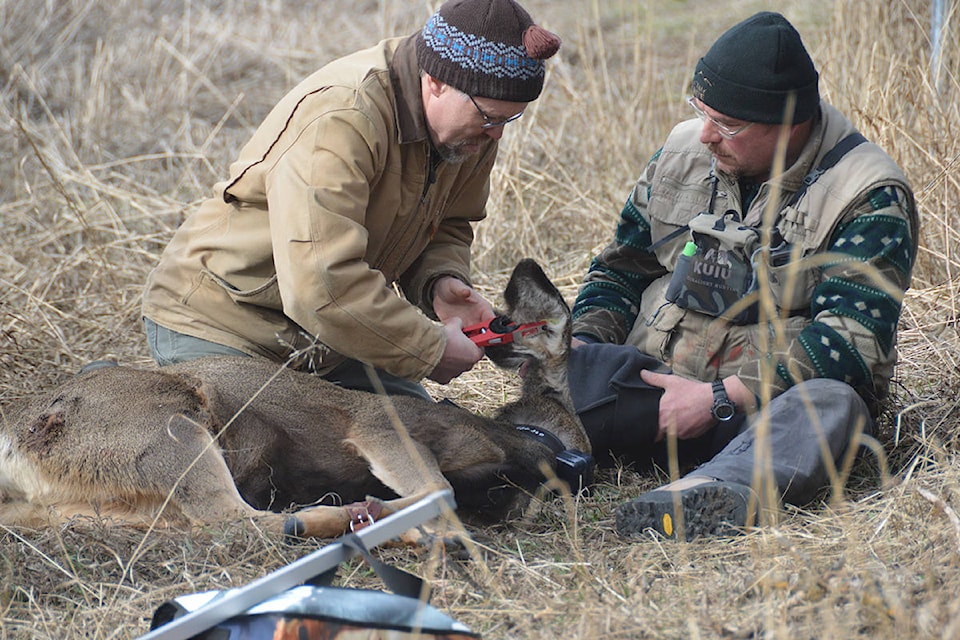Finding locations to move urban translocated deer that minimizes them from moving back to other regional communities was a major challenge identified in a report that studied and tracked the removal of urban deer from four regional communities.
The study, conducted by Vast Resource Solutions, tracked the translocation of 85 urban mule deer from Invermere, Kimberley, Cranbrook and Elkford to winter ranges areas. Of those deer, 47 were fitted with GPS collars to record their movements and transmit data back to wildlife biologists.
The movement of translocated habituated deer to other communities was a significant issue arising from the study, according to Ian Adams, a Senior Wildlife Biologist with Vast Resource Solutions who worked on the project.
“There was a wide range of responses of deer after we released them,” said Adams, in an interview with the Townsman. “The main stumbling block to continuing on with translocation was the propensity of some individuals, I think it was about 12 of 40 collared deer that showed up in other communities, and that is an outcome that we’re not looking for at all; the government doesn’t want that at all.
“…At the same time, there was also about the same number or more more deer that did revert to what we call natural mule deer habits; some of them did migrate and move back and fourth between newly established winter and summer ranges, others didn’t migrate at all, which isn’t necessarily a bad outcome.”
The objective of the study was to determine the causes of and mortality rates during the translocation process, document the movement of radio collared deer and compare translocated urban deer survival to non urban populations.
The capture process occurred in four communities in March and February 2016 where the urban deer were darted and moved to four winter ranges using modified stock trailers.
The conclusions noted that 16 mule deer moved to a town or community at some point, with 12 remaining in that town, according to the report.
“The movement of habituated deer to human development is a major potential limiting factor to the implementation of translocation as an ongoing operational tool to manage urban deer populations in the East Kootenay,” reads a section of the report’s executive summary.
As far as mortality rates went, the translocated deer had a 51 per cent mortality rate after the first year between March 2016 and April 2017.
“We had just over 50 per cent survivorship through the first year, which is definitely lower than non-urban deer populations,” said Adams, “but it’s comparable to what other translocation projects in the United States have found.”
Of those 24 deaths, 11 occurred by predation from bears, cougars or wolves, while six were attributed to human causes such as roadkill or railway, while seven were classified as other or unknown.
Adams said the predation rates on urban deer were slightly lower than non-urban deer, a conclusion they were able to reach as the Ministry of Forests, Lands and Natural Resource Operations is also concurrently running a five-year study that is monitoring four separate populations of non-urban mule deer.
“There was no evidence that these guys were predator-naive and didn’t know how to react around predators or look after themselves, which was a concern for a lot of people,” he said. “When this started, there was a fair number of people who thought it would be a cougar and wolf-feeding program, and that did not occur at all; we had no data to support that.”
In terms of migration, the non-urban deer were classified as migratory, non-migratory or wandering, with clear differences across the four originating municipalities where the deer were extracted from.
For example, two Kimberley urban deer migrated down to Cranbrook and Libby, Montana, respectively, while other wandering deer settled in other areas such as Baynes Lake, Canal Flats, Fairmont Hot Springs and Wasa.
The report noted that Kimberley urban deer seemed to be drawn to communities while deer removed from Invermere stayed away from towns and rural properties.
Some other specific conclusions reached was that clover trapping for capture was not efficient, release sites must be as far away from other communities as possible and that release sites around Lake Koocanusa are not suitable as none of the deer released in that area showed any migratory behaviour.
The study also concluded that using translocation as an urban deer management option requires a detailed and costed plan that responds to complaints of habituated deer.
For budgeting, the study said that the estimated cost for translocation for 30 ungulates comes out to $1,050 per deer, assuming a crew of four people working five days to capture six deer per day.
While the Vast Resource Solutions study has concluded, The City of Kimberley has recently pursuing a provincial research permit with $25,000 set aside for further translocation studies. The city is also pursuing an additional $25,000 in grant funding from the provincial government for the project.
